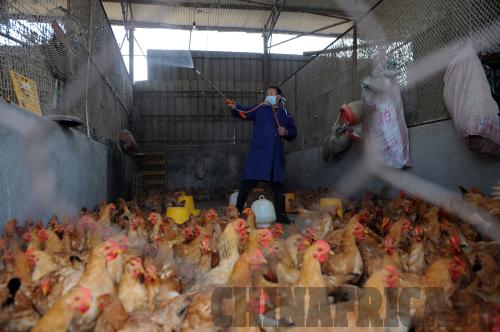|
 |
|
A poultry market is disinfected in Hangzhou, Zhejiang Province (HU YUANYONG) |
A new human infection with an animal flu virus has touched a raw nerve among the public and posed a challenge to China's disease control system, which is quickly responding to a possible outbreak by drawing on their experiences with previous epidemics.
As a strain of influenza A, H7N9 normally circulates among birds. However, the Chinese National Health and Family Planning Commission (NHFPC) confirmed the world's first three human cases on March 30, including an 87-year-old man and a 27-year-old man in Shanghai, both of whom died from pneumonia symptoms in early March. An H7N9-infected 35-year-old woman in Anhui Province died on April 9.
According to the NHFPC daily update on April 18, the country has reported a total of 87 cases of the new flu, including 17 fatalities and six cured.
A total of 32 cases have been reported in Shanghai. Jiangsu and Zhejiang provinces reported 21 and 27 cases respectively.
The commission said that no epidemiological link between those cases has yet been identified, and those who have been in close contact with people infected by H7N9 have been placed under medical observation, but haven't shown signs of infection.
All identified H7N9 patients show initial symptoms of fever and coughing, which develop into severe pneumonia in later stages.
Measures taken
The Chinese Center for Disease Control and Prevention (CDC) said on April 10 that testing reagents for the H7N9 avian influenza virus have been distributed to all flu monitoring sites across the country, and it has also provided major infectious disease hospitals and research agencies with testing and detection materials.
The CDC said earlier that it is maintaining communication with health authorities in other countries and regions to coordinate relevant technological cooperation. It is also assessing the pandemic risks of H7N9, and working with international experts to develop response strategies.
On April 7, the National Center for Food Safety Risk Assessment urged that preventive measures be put in place to ensure food safety, warning the public to avoid contact with potentially contaminated poultry.
The center also cautioned people to thoroughly cook eggs and poultry products, as it believes the virus cannot withstand high temperatures.
A laboratory under the Chinese Academy of Sciences (CAS) announced on April 10 that its researchers have ascribed the human infection to a genetic mutation of influenza strains caused by the mingling of different bird populations during migration.
According to the researchers, the genetic mutation is likely to have occurred in east China's Yangtze River Delta area, which is home to Shanghai, Zhejiang and Jiangsu, and where a virus carried by migrating wild birds from the South Korea and other regions in East Asia mingled with the avian influenza virus carried by local ducks and chickens.
Researchers also found that no H7N9 genes can be traced to pigs, thus excluding pigs as intermediate hosts for the deadly new strain of bird flu.
Both the governments of Shanghai and Nanjing, the capital city of Jiangsu, have suspended all live poultry trade, temporarily shut down poultry markets and banned the entry of live poultry from other parts of the country.
On April 4, the Shanghai Government ordered the culling of all birds in a live poultry trading area of an agricultural market after H7N9 bird flu was detected in pigeon samples.
|